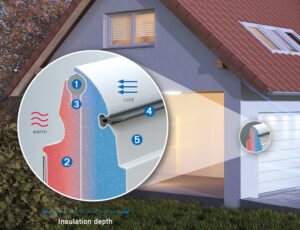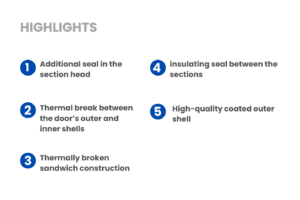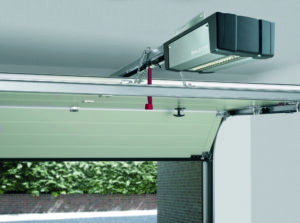Best Energy Saving Garage Doors
Garage Doors aren’t always an obvious weak point in your home when looking to save energy. Some of the leading culprits are typically windows, front doors, or poor insulation in the attic. Although this isn’t a particular issue with detached garages, heat loss in a home which has an integral garage perhaps under a bedroom, or used as a home office or gym, can be a problem. The amount of loss can vary depending on the size of the garage door, the type of insulation, and the weather. In this article we look at some of the best performing pre-insulated garage doors and contributing factors – What materials are the best? How can good design influence the outcome? Why does quality manufacture count?
What is the measure for heat loss?
Guidance amongst manufacturers is provided through U-values. The U value of a garage door is a measure of the amount of heat that passes through a surface area of 1m2 for each degree of temperature difference between the inside and outside. Therefore, the lower the U value, the more energy-efficient the material is.
Are there any building regulations?
Although there is no specific legislation directly applying U-values to insulated garage doors, Part L of the Building Regulations, concerning the conservation of fuel and power, does deal with garage conversions, for example when a previously exempt unheated space becomes part of a heated dwelling. A garage door used to access the space, if being retained or upgraded, may have to adhere to ‘change to energy’ status, in which case the energy efficiency requirements outlined in the regulations may apply.
Multi-layered protection.
In a similar fashion to people wearing lots of clothing layers in winter, garage door manufacturers use multi-layered construction techniques to save energy. This involves different materials to create a sandwich-like double skin in steel, aluminium, or vinyl, around rigid foam. This provides excellent insulation properties while maintaining the strength and durability of the door.
Examples of these include:
- Novoferm’s Evolution Premium, constructed as a broken sandwich panel design to create thermal separation of the outer and inner shells. The benefit is a significantly improved heat insulation value equal to 0.46 W/m2K when compared to other door solutions with 45 mm section thicknesses. (See highlights below)
- The Novoferm ISO70, a sub 1.0 W/m² K insulator which similarly comprises built-in layers of CFC free polyurethane rigid foam insulation between a galvanised steel double skin and a total section thickness of 70 mm.
- Hörmann’s galvanised steel 67 mm thick sectional garage door which also offers some of the lowest U-values below 1.0 W/m² K.
Furthermore, if you want to lighten a dark garage space with glazing that isn’t detrimental to the heat saving you seek, then, these can be supplied with a triple-glazed window that also provides excellent heat insulation.
Thermal Break Features of the Novoferm Evolution Premium


Do garage doors provide weather shielding?
With poorly insulated or low-grade products, air leaks can still occur around the edges of a garage door. This is why high-end manufacturers focus R&D on improving weather stripping around the door. Clever product innovation built into the ‘Evolution Premium’ and other models include all-surround seals (some double), as part of a ‘Thermo Frame’ design:
- In the section head
- Between each panel
- At the base of the door
Other manufacturers such as Hörmann similarly invest in weather-shielding features, with:
- Seals fitted to the floor closing the bottom edge of the door to provide barrier-free access whilst preventing the penetration of water – these seals also compensate for floor unevenness.
- Plastic profiles between the frame and brickwork to create a thermal break which improves insulation by up to 15% – a performance statistic which applies to their 5000×2250 mm double-skinned sectional garage door LPU 42 model.

Is wood a good insulator?
It’s no surprise that timber garage doors allow for better insulation and airtightness. Cedar wood’s cellular structure creates natural air spaces that give it an insulation value higher than most woods, as well as having excellent sound suppression and absorption qualities.
Are side hinged garage doors energy efficient?
Side hinged garage doors are available in single or double skin options. Single skin doors are a cost-effective option and are best suited to spaces where there’s no need for insulation or draught sealing. Double skin doors are a thicker, insulated alternative, better suited to environments where it’s important to keep them warm and dry. The Novoferm DuoPort side hinged garage door provides a good bespoke, made to order example of this, with a 45 mm rigid Polyurethane (PUR) foam core, coupled with a block door frame providing outstanding insulation.
Polyurethane systems are among the best-performing insulation materials used in construction (See the behaviour of polyurethane systems as thermal insulators). Low thermal conductivity is reached with a minimum of thickness, making for a lighter weight product, especially when the door leaf frames are also made from high-quality aluminium.
Sectional Doors v Roller Doors – Which are the best insulators?
Sectional garage doors are better at saving energy than roller garage doors. For all the reasons given above they are intentionally made and tested for this purpose. Roller garage doors, on the other hand, are made up of individual slats, which are foam-filled. As such they are perceived to be energy efficient. However, whilst this will offer some insulation, roller garage doors are untested on a fitted door. Because the interlock between the laths/slats are not sealed they are unable to carry a meaningful U value. The gaps simply don’t prevent air and moisture from escaping.
What other advantages are there?
The heat saving designs of high-quality garage doors also have other significant benefits.
- Absorbs sound: The insulation materials absorb internal and external noise. It creates low noise when opening and closing too, reducing unsettling rattles and creaks, compared to low value doors.
- Strength: Insulated options are stronger, compared to the uninsulated options. With more resistance to dents and damage, the highest quality sectional garage doors, for example when well maintained, can have an overall lifespan of more than 35 years.
Conclusion
As energy efficiency becomes increasingly important, garage door manufacturers are making strides in improving insulation properties. New materials, multi-layered construction, improved seal design, and weather stripping, are all contributing to the creation of garage doors that are more efficient than ever before. Homeowners looking to upgrade their garage doors can now choose from a range of options that provide superior insulation and help to reduce energy bills. Government incentives around upgrading homes such as the new ECO+ scheme will also help homeowners get onboard with eco-conscious products. There has never been a better opportunity to put energy efficiency at the heart of your home improvement project.

